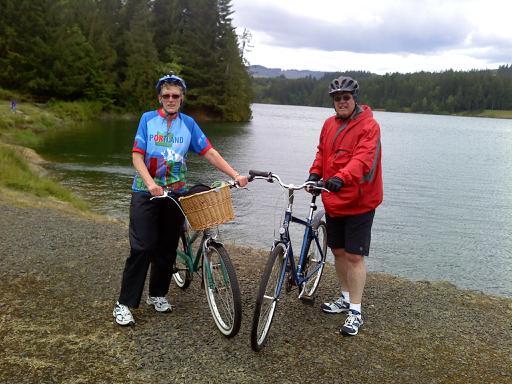No hills. Totally flat
Note:click on photos to see the whole pic. Sometimes only half shows up on the blog.
This morning we rode on the boat for a couple of hours before docking and setting out on our bikes. And because we were docked on the north side of the river, not the south, we learned that we were now in Belgium, not France. Because of changes due to the European Union, border crossings are a non-event. There wasn't even a sign, just this little poster.
We biked a few miles to the Belgian town of Ypres, which was a center of fighting in WWI, and which houses a fine museum about the war. The city was totally destroyed but has been rebuilt in the same style, so it appears like it was before the war. It is a beautiful town, built in the old Flemish style.
Here are some facts we learned as we toured the museum:
1) After WWI one in six men in France was killed or wounded.
2) Despite signs of rising militarism to the north, Belgium did not start military conscription or train a professional army until a year before Germany invaded, so they were totally unprepared for war.
3) Many of the soldiers serving in the Allied forces in WWI came from colonies of European nations, with different (unsuitable) uniforms and weaponry.
4) Soldiers in France, the United Kingdom and Belgium themselves had uniforms unsuitable for the trench warfare of the war -- plumed helmets, spiked helmets, brightly colored jackets, etc. which made them easy targets.
5) 13% of the entire Belgian army died in WWI.
6) Despite four years of warfare, the battle lines in Belgium moved only a few miles.
7) The countryside around the western section of Belgium and the majority of the buildings in this area were destroyed, but of the war reparations paid by Germany after the war, the vast majority went to France and England. Belgian people paid for nearly all the rebuilding that was done.
8) Around thirty WWI bodies are still found every year in this area, along with miscellaneous unexplored ordnance.
What we saw: Military cemeteries with graves of allied victims are located every few miles through the countryside around Ypres. During the four years when battle raged here, about 300,000 soldiers died and most are buried here. Many of the graves are of unidentified soldiers.  This is the Menin gate, leaving Ypres. It has the names of 54,000 officers and men from Canada, Australia, India, South Africa and the United Kingdom who died prior to August 1917 and whose bodies are still missing.
This is the Menin gate, leaving Ypres. It has the names of 54,000 officers and men from Canada, Australia, India, South Africa and the United Kingdom who died prior to August 1917 and whose bodies are still missing.

Notice the difference in inscriptions. The one on the left says, "Believed to be buried in this cemetery," while the one on the right says, "Known to be buried in this cemetery."
The grave sites are beautifully tended by local citizens. The decorations above the names represent the units the soldiers served in.
 This is the Menin gate, leaving Ypres. It has the names of 54,000 officers and men from Canada, Australia, India, South Africa and the United Kingdom who died prior to August 1917 and whose bodies are still missing.
This is the Menin gate, leaving Ypres. It has the names of 54,000 officers and men from Canada, Australia, India, South Africa and the United Kingdom who died prior to August 1917 and whose bodies are still missing. Because it is Belgium, Wm. and I bought some chocolates from Leonidas Chocolates and shared them with our virtual grand kids.
On the way back to the barge we ran across a garden open house, so we took a look. The garden is owned by a sculptor, who had many of these plastic men statues placed strategically around. Here's William doing a life imitates art impression.

After we returned tithe barge, we motored up the river a little and ended up in Kortrijk. A barge from a different bike/barge company pulled up alongside us and roped onto our barge for the night. The folks from their barge walk over our deck to get to shore. Not unusual around here but very interesting to look out the window directly into another barge.












No comments:
Post a Comment